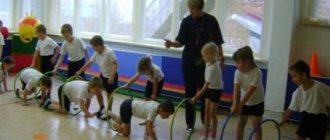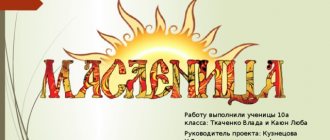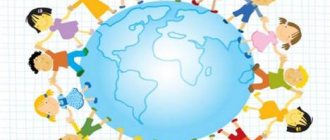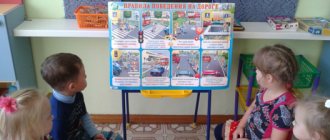Project “Health Week” in the second junior group 11
Transcript
1 Project motto: “A healthy lifestyle is what ensures health and brings joy.” Project “Health Week” in the second junior group 11 Teachers: Kirgizova V.M. Medvedeva Y.V.
2 Taking care of health is the most important work of a teacher. Their spiritual life, worldview, mental development, strength of knowledge, and self-confidence depend on the cheerfulness and vigor of children. V.A. Sukhomlinsky Duration of the project: short-term (1 week) Time of implementation: since 2011 Type of project: educational and gaming Project participants: educators, children and their parents Age of children: second junior group (3-4 years) Project problem: Growth the number of diseases in children is associated not only with the socio-ecological situation, but also with the very lifestyle of the child’s family, which largely depends on family traditions and the nature of the motor regime. If the child’s physical activity is insufficient (physical inactivity), a deterioration in the development of motor function and a decrease in the child’s physical performance inevitably occur. Today it is important for us, adults, to form and maintain an interest in improving the health of both ourselves and our children. “Parents are the first teachers. They are obliged to lay the foundations for the physical, moral and intellectual development of the child’s personality in infancy” (Clause 1 of Article 18 of the Law of the Russian Federation “On Education”).
3 Project goal: developing a culture of health in children 3-4 years old; maintaining and strengthening children's health; introducing children and their parents to a healthy lifestyle. Project objectives: - pay special attention to educators and parents to the formation and strengthening of the child’s health, in order to create around him the need and habit of a healthy lifestyle; - create an educational condition for children, which would become an opportunity to develop a unified style of behavior and strategy for raising a healthy lifestyle for the child. -for children: 1) strengthen and protect the health of children; 2) create the need to maintain hygiene skills; 3) give an idea of the value of health, create a desire to lead a healthy lifestyle; 4) give an idea of healthy and unhealthy foods for human health. -for parents: 1) give parents an idea of the importance of joint physical activity with children, healthy and unhealthy foods, maintaining hygiene skills, etc.; 2) promote the creation of an active position of parents in joint physical activity with children; 3) to interest parents in strengthening a healthy lifestyle in the family.
4 Developmental subject-spatial environment
5 Educational area “Physical development” 1. Healthy running around the kindergarten 2. Outdoor games: “Grey Bunny”, “Bear in the Forest”, “Mice Do a Round Dance” 3. Entertainment with children “Winter Fun”
6 Entertainment with children “Winter fun”
7 Daily preventive work: 1. Acupressure. 2. Visual gymnastics 3. Breathing gymnastics. 4. Finger gymnastics 5. Relieving mental fatigue during NOD (relaxation breaks, physical exercise, ear massage). 6. Hardening 7. Walks 8. Optimal motor mode. The one who gets up with the sun, does exercises, brushes his teeth in the morning and plays hide and seek, is a sporty person, and quite cheerful. Try to be like this in kindergarten and at home.
8 Finger gymnastics Promotes mastery of fine motor skills Helps develop speech Increases the performance of the cerebral cortex Develops mental abilities: thinking, memory, imagination Relieves anxiety Breathing exercises Positively affects metabolic processes that play an important role in blood supply, including pulmonary tissue Improves drainage function bronchi; — restores impaired nasal breathing; helps restore normal blood and lymph supply; increases the overall resistance of the body
9 Acupressure and self-massage Positively affects metabolic processes that play an important role in blood supply, including pulmonary tissue. Improves the drainage function of the bronchi; — restores impaired nasal breathing Helps restore normal blood and lymph supply Increases the body’s overall resistance Gymnastics for the eyes Improves circulation of blood and intraocular fluid of the eyes Strengthens the eye muscles Improves accommodation (this is the ability of the human eye to have good quality vision at different distances)
10 Compliance with cultural and hygienic skills Hardening Brush your teeth, wash your face, And smile more often, Temper yourself, and then you won’t be afraid of the blues.
11 Physical exercises Relaxation Teaches children to relax Promotes concentration Helps relieve tension Relieves agitation
12 Educational area “Artistic and aesthetic development” 1. Application “Healthy vegetables and fruits” 2. Modeling “One day a housewife came from the market” Eat vegetables and fruits - These are the best products. You will be saved from all diseases. There is nothing tastier and healthier than them. Make friends with vegetables, And with salads and cabbage soup. There are countless vitamins in them. So you need to eat it!
13 Educational area “Cognitive development” 1. GCD Vegetables, fruits, healthy products! 2. Situational conversation “Where do vitamins live?” 3. Interactive game on healthy lifestyle “Vitamins” 4. Quiz “We choose health”
14 Screening of presentations “Types of sports”, “Vitamins”
15 Educational area “Social and communicative development” 1. Creation of game situations: “Bunny Ears got sick”; “Let’s teach the doll Masha to wash herself”; “Doctor Aibolit came to visit us,” “Dirty girl.” 2. Creation of conditions for role-playing games “Hospital”, “At the doctor’s”, “Family”. 3. Puppet theater show Creating a game situation and “Bunny Ears is sick”
16 Creating a game situation “Let’s teach the doll Masha to wash herself” “Doctor Aibolit came to visit us”
17 Puppet theater show “Visiting Aibolit”
18 Educational area “Speech development” 1. Reading works: K. Chukovsky “Moidodyr”, “Aibolit”, V. Berestov “Lezheboka”, S. Mikhalkov “About a girl who ate poorly”, A. Bach “We need to play sports” , P. Efimov “Poem about physical education”, A. Barto “Dirty Girl” 2. Examination of illustrations on healthy lifestyle 3. Viewing and discussion of the cartoon “Smeshariki and the ABC of Health” 4. Staging of the poem “What are eyes for in the world” Viewing and discussion of the cartoon “Smeshariki and the ABC of Health” Dramatization of the poem “What are eyes for in the world”
19 Working with parents 1. Creating a folder for parents: “Strengthening the health of children in the family” (memos, recommendations, booklets). 2. Questioning of parents “About a healthy lifestyle” 3. Design of a photo newspaper “We are strong friends with sports.” 4. Consultations: “Outdoor games with children at home and on the street,” “Hardening in kindergarten,” “The role of the family in the physical education of a child.”
20 HEALTHY CHILDREN IS A HEALTHY COUNTRY! Thank you for your attention!




